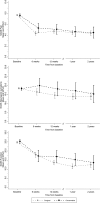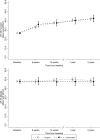Surgical versus conservative treatment for lumbar disc herniation: a prospective cohort study
- PMID: 28003290
- PMCID: PMC5223716
- DOI: 10.1136/bmjopen-2016-012938
Surgical versus conservative treatment for lumbar disc herniation: a prospective cohort study
Abstract
Objectives: Evidence comparing the effectiveness of surgical and conservative treatment of symptomatic lumbar disc herniation is controversial. We sought to compare short-term and long-term effectiveness of surgical and conservative treatment in sciatica symptom severity and quality of life in patients with lumbar disc herniation in a routine clinical setting.
Methods: A prospective cohort study of a routine clinical practice registry consisting of 370 patients. Outcome measures were the North American Spine Society questionnaire and the 36-Item Short-Form Health Survey to assess patient-reported back pain, physical function, neurogenic symptoms and quality of life. Primary outcomes were back pain at 6 and 12 weeks. Standard open discectomy was assessed versus conservative interventions at 6, 12, 52 and 104 weeks. We filled in missing outcome variable values with multiple imputation, accounted for repeated measures within patients with mixed-effects models and adjusted baseline group differences in relevant prognostic indicators by inverse probability of treatment weighting.
Results: Surgical treatment patients reported less back pain at 6 weeks than those receiving conservative therapy (-0.97; 95% CI -1.89 to -0.09), were more likely to report ≥50% decrease in back pain symptoms from baseline to 6 weeks (48% vs 17%, risk difference: 0.34; 95% CI 0.16 to 0.47) and reported less physical function disability at 52 weeks (-3.7; 95% CI -7.4 to -0.1). The other assessments showed minimal between-group differences with CIs, including the null effect.
Conclusions: Compared with conservative therapy, surgical treatment provided faster relief from back pain symptoms in patients with lumbar disc herniation, but did not show a benefit over conservative treatment in midterm and long-term follow-up.
Keywords: SURGERY; conservative; hernia; prolapse; sciatica.
Published by the BMJ Publishing Group Limited. For permission to use (where not already granted under a licence) please go to http://www.bmj.com/company/products-services/rights-and-licensing/.
Conflict of interest statement
PJ has received research grants to the institution from Astra Zeneca, Biotronik, Biosensors International, Eli Lilly and The Medicines Company, and serves as unpaid member of the steering group of trials funded by Astra Zeneca, Biotronik, Biosensors, St Jude Medical and The Medicines Company. The other authors report no conflict of interest.
Figures



References
-
- Koes BW, van Tulder MW, Peul WC. Diagnosis and treatment of sciatica. BMJ 2007;334:1313–17. 10.1136/bmj.39223.428495.BE - DOI - PMC - PubMed
Publication types
MeSH terms
LinkOut - more resources
Full Text Sources
Other Literature Sources
Medical
